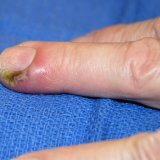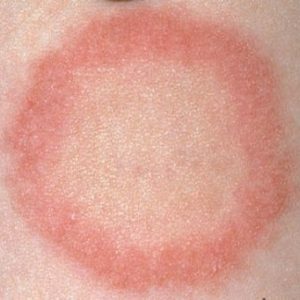Panaritium: clinic, diagnosis, treatment

Causes of the Panicium
The most common causative agent of the panic is staphylococcus aureus( golden hemolytic or white).Metabolic disorders, decreased immunity, endocrine diseases, cold - all this contributes to the emergence of a panic. The ingress of chemicals and certain metals in the wound also contributes to this.
Panaritium: clinic
There are several types of panaritium - subcutaneous, subungual, okolonogtevoj, cutaneous, bony, tendon, articular, pandaclitit. In the presence of any panic, acute pulsating pain is observed. The pain increases when the finger is flexed and unbent. The main symptom of the disease is puffiness and redness of the finger, especially from the back side. At the stage of suppuration, the pain becomes so strong that it can lead to insomnia. In this case, there may be an increase in temperature, malaise, general weakness, an increase in lymph nodes.
Cutaneous panaritium is characterized by the appearance of a blood-purulent bladder, often occupying the entire surface of the finger.
A peri-oral feces( paronychia) is characterized by the formation of purulent inflammation in the thickness of the nail. Around the affected area, the skin swells and turns red.
With subungual panaritium purulent inflammation is formed under the fingernail, when penetrated under the nail chipped wounds. At the same time, drops of pus can form on the nail, it arches and rises above the finger. This type of panaritium is characterized by severe pain.
In subcutaneous panaritium( the most common form of the disease), pus affects the subcutaneous tissue of the finger. Usually subcutaneous felonies occur on the inside of the finger, on the tip. In this case, there is a swelling, edema of the lateral surfaces of the finger. Very quickly, infection passes to the tendons and joints of the finger. The body temperature rises, acute acute pain appears.
With bone felon, inflammation affects the bones of the finger. There are primary and secondary bone felon. Primary panaritium occurs with deep penetrating wounds, secondary - due to the complication of other panaricians. With inflammation the finger swells, acute acute pain is observed, the temperature rises, there is a headache and chills. Purulent inflammation can spread to the joints and tendons.
Joint articulations affect the joints of the fingers. There are 2 stages of the disease: the first affects only soft tissues, the second appears pain when the joint moves, the destruction of cartilage and bones begins. Sometimes there is a canal( fistula) for the exit of pus.
With a tendon felon, purulent inflammation affects the extensor element of the tendon of the finger. The main sign of this disease is a constant pain throughout the tendon. The blood vessels of the tendon are squeezed, the tissue of the tendon dies, as a result of which the extension of the finger is accompanied by painful pain. Often the inflammation passes to the brush and to the adjacent fingers.
Sometimes after any form of panic a complication can occur when all the tissues of the finger become inflamed. Such a disease is called pandactylitis.
If you do not detect the disease in time and start treatment, a purulent inflammation can spread from one finger to the other, go to the wrist, to the forearm, and so on. If the treatment is delayed, scars can form, in case of acute inflammatory process, as a result of tissue death, the functions of damaged organs can be damaged.
Panaritium: Diagnosis
Diagnosis is based on the above symptoms.
Panaritium: treatment of
Treatment should be prompt. At the beginning of the disease, antibiotics, hot baths, physiotherapy procedures are prescribed, the arm should be in a fixed position. With a reduction in the acute inflammatory process( or after surgery), therapeutic gymnastics is recommended.
In operations, the abscess is opened, the dead tissue is removed, drainage is made, through which pus will leave. After the operation, make an antiseptic bandage. With neglected forms of the disease, one has to do an amputation of the phalanx of the finger.
A timely contact with a doctor is very important for effective treatment.
Preventive measures panaritium
The main method of prevention is the timely treatment of wounds, abrasions, cuts with any antiseptic( zebra, iodine, alcohol, etc.).
If splinters get into the finger, remove it immediately. If you can not do this yourself, ask your doctor for help.



